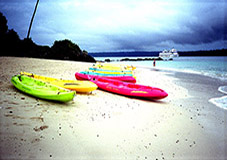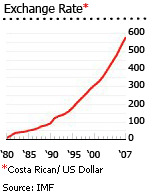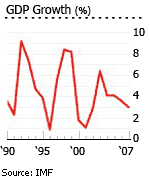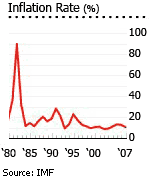Baby boomers just love Costa Rica
 Costa Rica is in the eye of a spectacular property boom Central America. Its beaches and central valleys have now been truly discovered by U.S. buyers.
Costa Rica is in the eye of a spectacular property boom Central America. Its beaches and central valleys have now been truly discovered by U.S. buyers.
Sun, surf, beautiful valleys, volcanoes, jungles, excellent security, good infrastructure, low costs and choice of climate (dry or humid, depending on whether Pacific or Caribbean) have proved irresistible attractions for tourists, buyers, the adventurous young, and retirees.
It is no longer so cheap. “People think that you can buy something here for US$50,000 - but you cannot,” says Brad Butler of Heredia’s Emerald Forest Properties.
“This is the Switzerland of Latin America. You will pay US$200,000 minimum for a house, US$300,000 for a livable house, US$400,000 for something nice, and US$500,000 for a beautiful house.”
The Northern Pacific coast’s Guanacaste province (see map) illustrates the boom process. For years this was a wild woolly territory, hard to get to, the domain of backpackers and surfers who appreciated its climate and stunning beaches.
Guanacaste tansformed
But in the last three years Guanacaste has been transformed. The catalyst was the start of direct flights from Atlanta, Miami and Houston three years ago. They fly into the small airport at Liberia, the capital of Guanacaste.
 The core of the boom is the 2,300-acre (9.3 sq. km.) US$400 million Península Papagayo project, indisputably the most luxurious development on the coast, developed by Alan Kelso, a Costa Rican developer. Península Papagayo has a Four Seasons resort and is expected to include three more hotels including a Barcelo Hotel and more than 1,000 luxury homes, although at the moment only 44 houses and condos have been built, selling for US$2 million to $12 million.
The core of the boom is the 2,300-acre (9.3 sq. km.) US$400 million Península Papagayo project, indisputably the most luxurious development on the coast, developed by Alan Kelso, a Costa Rican developer. Península Papagayo has a Four Seasons resort and is expected to include three more hotels including a Barcelo Hotel and more than 1,000 luxury homes, although at the moment only 44 houses and condos have been built, selling for US$2 million to $12 million.
Kelso also plans a marina, a polo field and three golf courses. Península Papagayo has put in roads, sewers, buses, electricity and its own medical services and fire brigade, and was part of the group that lent money for the airport.
At Hacienda Pinilla, hundreds of condominiums and villas are being built around 4,500 acres of nature preserve by the Atlanta-based owner, Hoover Gordon Pattillo, who bought the land as a family vacation homestead 30 years ago. Over two weeks last year, Hacienda Pinilla sold 43 Spanish colonial condominiums for US$580,000 and up - without any advertising.
Prices in Guanacaste have risen four times in the last three years, 10 times over ten years.
“Maybe properties 15 years ago cost US$20 per sq. m., now they would cost US$250/3000 per sq. m.,” says Edwin Sanchez, regional operations director of Century 21, who is based in Costa Rica. “The most attractive properties are close to the beaches with a very good sea view.”
The area’s promoters have taken to calling it the new Gold Coast (see New York Times). Guanacaste is known as the dry forest, and is low in humidity and has just two seasons- the Green Season, May to November. when there are morning or afternoon showers that clear to provide spectacular sunsets, and the High Season, with beautiful sunny days from November to May.
The Central Valley - 25% p.a. price growth
Costa Rica gives buyers many choices. For year-round living the Central Valley has a temperate climate and easy access to San José, the country’s rather ugly capital, but its economic and cultural center.
Small-town charm a half-hour away from the capital are offered in the mountains of Heredia to the north, Alajuela to the northwest and Cartago to the east offer. The warm climate on the hills of Escazú, west of San José, are a favorite with North American expatriates.
Heredia attracts a lot of retired people. “They are attracted by the climate, activities, that it is close to hospitals, close to airport, close to beaches, and has a central location,” says Butler.
 Heredia has seen 25% price growth annually for the past four years. The market boom began almost immediately after 2002 shock collapse of a Ponzi scheme called Ofinter SA run by businessman Luis Enrique Villalobos, which owned US$1 billion to 6,300 investors, mainly North American. Three months later another Ponzi scheme called Savings Unlimited went down, trapping another 2,800 investors.
Heredia has seen 25% price growth annually for the past four years. The market boom began almost immediately after 2002 shock collapse of a Ponzi scheme called Ofinter SA run by businessman Luis Enrique Villalobos, which owned US$1 billion to 6,300 investors, mainly North American. Three months later another Ponzi scheme called Savings Unlimited went down, trapping another 2,800 investors.
“For example, a friend of mine bought a 46-acre (186,155 sq. m.) property for US$500,000 five years ago [in Heredia]. Now he has just sold it for US$7 million,” says Butler.
Costa Rica investors are reassured by the democratically elected government, lack of a military, as well modern medical care and facilities, clean air, and good drinking water. The downside is that “The country increasingly has become a part of America,” says Butler.
“Anything you can find in the States, you can find here. There is Wall Mart, American Depot, TGI Fridays, and all the chains. It is not a Third World country any more.”
Costa Rica’s last frontier is the Osa peninsula area (map), which is very rural, not easily accessible, a small airport and terrible roads. But it is also much more tropical, an area known for its heat and mosquitoes and snakes.
The Caribbean beaches
The Caribbean beaches, especially those near the Panamanian border, are some of the most beautiful and unspoiled in the country.
Even more than the Central Valley, the beaches are seeing enormous price increases.
“Jaco Beach was really a hippie town, but eight months ago some developers came in, and wow that is booming,” says Butler. “Things are just crazy on the beaches. Hermoso has done very very well in the past two years, its seen the largest increases in the country. ”
Real estate transactions are typically quoted in US dollars. As the Costa Rican colon (CRC) depreciated from 149.2 to 168 colons per US dollar from 2004 to 2005, real estate prices become more expensive from Costa Rican point of view. The colon is expected is expected to depreciate further to 184 colons per US dollar in 2006.
 Costa Rica’s ‘local’ property market is totally different from its ‘foreign’ market, and has not experienced the same boom. The capital San Jose (map) has seen slow and stable house price inflation, but in real terms the value of property has been static, except arguably in the West of San Jose, in Escazú and Santa Ana, suburban areas which have seen a lot of investment in hotels, motels, restaurants, commercial centres, golf courses, and offices, creating a chain effect which has also boosted residential prices.
Costa Rica’s ‘local’ property market is totally different from its ‘foreign’ market, and has not experienced the same boom. The capital San Jose (map) has seen slow and stable house price inflation, but in real terms the value of property has been static, except arguably in the West of San Jose, in Escazú and Santa Ana, suburban areas which have seen a lot of investment in hotels, motels, restaurants, commercial centres, golf courses, and offices, creating a chain effect which has also boosted residential prices.
Costa Rica has one of the best housing systems in Latin America. The housing stock stood at 1,033,939 units in 2000, of this less than 10% is considered to be in bad condition. The number of houses occupied was at 935,289; 74% is owner-occupied, 17% is rented while the remaining 9% is classified as others.
Stagnant rents
After the passage of the Law 7527 (Ley General de Arrendamientos Urbanos y Suburbanos or General Law on Urban and Suburban Renting) in 1995, rents in San Jose fell by 63.5%. Even if rents rose by 17% and 14% in 1996 and 1997, respectively, rents are still below their 1994 level. From 2000 to 2004, average annual rent growth was at 6.8%.
 However, there is something unusual about the law. Rents quoted in colon cannot be increased by more than 15% unless inflation is beyond 15%, (something that has not happened since 1996, however, inflation is still high at 12.6% in 2005).
However, there is something unusual about the law. Rents quoted in colon cannot be increased by more than 15% unless inflation is beyond 15%, (something that has not happened since 1996, however, inflation is still high at 12.6% in 2005).
Rents quoted in US dollars or any other currency cannot be increased (but with the mentioned depreciation of the colon, rents quoted in dollars are actually increasing annually faster than rents quoted in colons).
Given that residential property prices are rising at an average of 3 to 4% annually, real estate prices are falling in real terms. Average inflation rate from 2000 to 2005 was 11% while the average rate of depreciation of the colon (which can be interpreted as a fall in real estate prices if the dollar quoted price remain the same) is 8.6%.